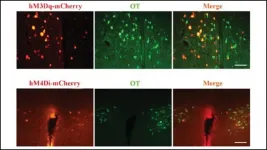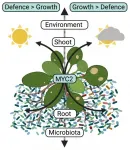(Press-News.org) Nanomaterials found in consumer and health-care products can pass from the bloodstream to the brain side of a blood-brain barrier model with varying ease depending on their shape - creating potential neurological impacts that could be both positive and negative, a new study reveals.
Scientists found that metal-based nanomaterials such as silver and zinc oxide can cross an in vitro model of the 'blood brain barrier' (BBB) as both particles and dissolved ions - adversely affecting the health of astrocyte cells, which control neurological responses.
But the researchers also believe that their discovery will help to design safer nanomaterials and could open up new ways of targeting hard-to-reach locations when treating brain disease.
Publishing its findings today in PNAS, an international team of researchers discovered that the physiochemical properties of metallic nanomaterials influence how effective they are at penetrating the in vitro model of the blood brain barrier and their potential levels of toxicity in the brain.
Higher concentration of certain shapes of silver nanomaterials and zinc oxide may impair cell growth and cause increased permeability of the BBB, which can lead to the BBB allowing easier brain access to these compounds.
The BBB plays a vital role in brain health by restricting the passage of various chemical substances and foreign molecules into the brain from surrounding blood vessels.
Impaired BBB integrity compromises the health of the central nervous system and increased permeability to foreign substances may eventually cause damage to the brain (neurotoxicity).
Study co-author Iseult Lynch, Professor of Environmental Nanosciences at the University of Birmingham, commented: "We found that silver and zinc oxide nanomaterials, which are widely used in various daily consumer and health-care products, passed through our in vitro BBB model, in the form of both particles and dissolved ions.
"Variation in shape, size and chemical composition can dramatically influence nanomaterials penetration through the (in vitro) blood brain barrier. This is of paramount importance for tailored medical application of nanomaterials - for example targeted delivery systems, bioimaging and assessing possible risks associated with each type of metallic nanomaterial."
The BBB is a physical barrier composed of a tightly packed layer of endothelial cells surrounding the brain which separates the blood from the cerebrospinal fluid allowing the transfer of oxygen and essential nutrients but preventing the access of most molecules.
Recent studies found nanomaterials such as zinc oxide can accumulate on the brain side of the in vitro BBB in altered states which can affect neurological activity and brain health. Inhaled, ingested, and dermally-applied nanomaterials can reach the blood stream and a small fraction of these may cross the BBB - impacting on the central nervous system.
The researchers synthesised a library of metallic nanomaterials with different particle compositions, sizes, and shapes - evaluating their ability to penetrate the BBB using an in vitro BBB model, followed by assessment of their behaviour and fate in and beyond the model BBB.
Co-author Zhiling Guo, a Research Fellow at the University of Birmingham, commented: ""Understanding these materials' behaviour once past the blood brain barrier is vital for evaluating the neurological effects arising from their unintentional entry into the brain. Neurotoxicity potential is greater in some materials than others, due to the different ways their shapes allow them to move and be transported."
The research team tested varied sizes of cerium oxide and iron oxide, along with zinc oxide and four different shapes of silver - spherical (Ag NS), disc-like (Ag ND), rod-shaped (Ag NR) and nanowires (Ag NW).
Zinc oxide slipped through the in vitro BBB with the greatest ease. The researchers found spherical and disc-like silver nanomaterials underwent different dissolution regimes - gradually transforming to silver-sulfur compounds within the BBB, creating 'easier' entry pathways.
Zinc oxide is used as a bulking agent and a colorant. In over-the-counter drug products, it is used as a skin protectant and a sunscreen - reflecting and scattering UV radiation to help reduce or prevent sunburn and premature aging of the skin. Silver is used in cosmetic and skincare products such as anti-aging creams.
INFORMATION:
For more information, interviews or an embargoed copy of the research paper, please contact Tony Moran, International Communications Manager on +44 (0)782 783 2312. For out-of-hours enquiries, please call +44 (0) 7789 921 165.
Notes for editors
* The University of Birmingham is ranked amongst the world's top 100 institutions, its work brings people from across the world to Birmingham, including researchers and teachers and more than 6,500 international students from over 150 countries.
* 'Biotransformation modulates the penetration of metallic nanomaterials across the blood brain barrier' - Zhiling Guo, Peng Zhang, Swaroop Chakraborty, Andrew J Chetwynd, Fazel Abdolahpur Monikh, Christopher Stark, Hanene Ali-Boucetta, Sandra Wilson, Iseult Lynch and Eugenia Valsami-Jones is published by PNAS.
Like female voles, connections between oxytocin neurons in the hypothalamus and dopamine neurons in reward areas drive parental behaviors in male voles, according to new research published in JNeurosci.
Motherhood receives most of the attention in the research world, yet in 5% of mammals -- including humans -- fathers provide care, too. The "love hormone" oxytocin plays a role in paternal care, but the exact neural pathways underlying the behavior were not known.
He et al. measured the neural activity of vole fathers while they interacted with their offspring. Oxytocin neurons connecting the hypothalamus to a reward area fired when the fathers cared for their offspring. ...
The psychedelic drug psilocybin, a naturally occurring compound found in some mushrooms, has been studied as a potential treatment for depression for years. But exactly how it works in the brain and how long beneficial results might last is still unclear.
In a new study, Yale researchers show that a single dose of psilocybin given to mice prompted an immediate and long-lasting increase in connections between neurons. The findings are published July 5 in the journal Neuron.
"We not only saw a 10% increase in the number of neuronal connections, but also they were on average about 10% larger, so the connections were stronger as well," said Yale's Alex Kwan, associate professor of psychiatry and of neuroscience and senior author of the paper.
Previous ...
A new collaborative research led by researchers from the National Institute for Environmental Studies, Potsdam Institute for Climate Impact Research, Ritsumeikan University, and Kyoto University found that although unlimited irrigation could increase global BECCS potential (via the increase of bioenergy production) by 60-71% by the end of this century, sustainably constrained irrigation would increase it by only 5-6%. The study has been published in Nature Sustainability on July 5.
Bioenergy with carbon capture and storage (BECCS) is a process of extracting bioenergy from biomass, ...
"The number of black holes is roughly three times larger than expected from the number of stars in the cluster, and it means that more than 20% of the total cluster mass is made up of black holes. They each have a mass of about 20 times the mass of the Sun, and they formed in supernova explosions at the end of the lives of massive stars, when the cluster was still very young" says Prof Mark Gieles, from the Institute of Cosmos Sciences of the University of Barcelona (ICCUB) and lead author of the paper.
Tidal streams are streams of stars that were ejected from disrupting ...
Land plants - plants that live primarily in terrestrial habitats and form vegetation on earth - are anchored to the ground through their roots, and their performance depends on both the belowground soil conditions and the aboveground climate. Plants utilize sunlight to grow through the process of photosynthesis where light energy is converted to chemical energy in chloroplasts, the powerhouses of plant cells. Therefore, the amount and quality of light perceived by chloroplasts through light absorbing pigments, such as chlorophyll, is a defining factor in plant growth and health. ...
MADISON, Wis. -- About 100 additional wolves died over the winter in Wisconsin as a result of the delisting of grey wolves under the Endangered Species Act, alongside the 218 wolves killed by licensed hunters during Wisconsin's first public wolf hunt, according to new research.
The combined loss of 313 to 323 wolves represents a decline in the state's wolf population of between 27% and 33% between April 2020 and April 2021. Researchers estimate that a majority of these additional, uncounted deaths are due to something called cryptic poaching, where poachers hide evidence of illegal killings.
The findings are the first estimate of Wisconsin's wolf population since the public hunt in February, which ended early after hunters ...
The theory that modern society is too clean, leading to defective immune systems in children, should be swept under the carpet, according to a new study by researchers at UCL and the London School of Hygiene & Tropical Medicine.
In medicine, the 'hygiene hypothesis' states that early childhood exposure to particular microorganisms protects against allergic diseases by contributing to the development of the immune system.
However, there is a pervading view (public narrative) that Western 21st century society is too hygienic, which means toddlers and children are likely to be less exposed to germs in early life and so become less resistant to allergies.
In this paper, published in the Journal of Allergy and Clinical Immunology, researchers point to four significant reasons which, ...
Research published today has demonstrated the viability of 3D-printed tissue scaffolds that harmlessly degrade while promoting tissue regeneration following implantation.
The scaffolds showed highly promising tissue-healing performance, including the ability to support cell migration, the 'ingrowth' of tissues, and revascularisation (blood vessel growth).
Professor Andrew Dove, from the University of Birmingham's School of Chemistry, led the research group and is the lead author on the paper published in Nature Communications, which characterises the physical properties of the scaffolds, and explains how their 'shape memory' is key to promoting tissue regeneration. ...
Flies have discriminating taste. Like a gourmet perusing a menu, they spend much of their time seeking sweet nutritious calories and avoiding bitter, potentially toxic food. But what happens in their brains when they make these food choices?
Yale researchers discovered an interesting way to find out. They tricked them.
In a study that could also help illuminate how people make food choices, the researchers gave hungry fruit flies the choice between sweet, nutritious food laced with bitter quinine and a less sweet, but not bitter, food containing fewer calories. Then, using neuroimaging, they tracked neural activity in their brains as they made these tough choices.
So which won? Calories or better taste?
"It depends on how hungry they are," said Michael Nitabach, professor of ...
Researchers at Uppsala University have discovered lymph node-like structures close to the tumour in brain cancer patients, where immune cells can be activated to attack the tumour. They also found that immunotherapy enhanced the formation of these structures in a mouse model. This discovery suggests new opportunities to regulate the anti-tumour response of the immune system.
Glioma is a deadly brain tumour with a dismal prognosis. One reason why brain tumours are very hard to treat is that our immune system, which is designed to detect and destroy foreign ...

